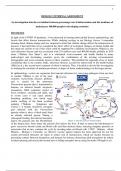Exam (elaborations)
DATABASE IB BIOLOGY IA - An investigation into the correlation between percentage rate of deforestation and the incidence of malaria in developing countries
- Course
- Institution
- Book
This document is a DATABASE IB Biology HL Internal Assessment, it is an IA that got a very high score. It investigates the correlation between the percentage rate of deforestation and the incidence of malaria per 100,000 people in developing countries. This can help you get a high mark for your IB ...
[Show more]




